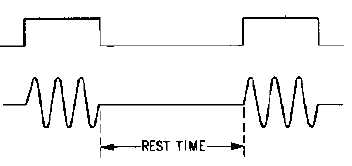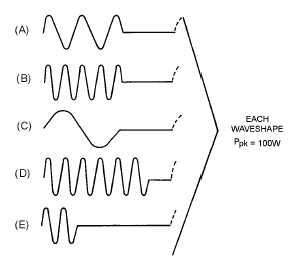2-37
The time we have been referring to as the time of no pulse, or nonpulse time, is referred to as REST
TIME (rt). The duration of this rest time will determine certain capabilities of the pulse-modulation
system. The pulse width is the time that the transmitter produces rf oscillations and is the actual pulse
transmission time. During the nonpulse time, shown in figure 2-36, the transmitter produces no
oscillations and the oscillator is cut off.
Figure 2-36.—Rest time (rt).
Some pulse transmitter-receiver systems transmit the pulse and then rest, awaiting the return of an
echo. Rest time provides the system time for the receive cycle of operation.
Power in a Pulse System
When discussing power in a pulse-modulation system, we have to consider PEAK POWER and
AVERAGE POWER. Peak power is the maximum value of the transmitted pulse; average power is the
peak power value averaged over the pulse-repetition time. Peak power is very easy to see in a pulse
system. In figure 2-37, all pulsed wave shapes have a peak power of 100 watts. Also note that in views
(A), (B), and (C) the pulse width is the same, even though the carrier frequency is different. In these three
cases average power would be the same. This is because average power is actually equal to the peak
power of a pulse averaged over 1 operating cycle. However, the pulse width is increased in view (D) and
we have a greater average power with the same prt. In view (E) the decreased pulse width has decreased
average power over the same prt.
Figure 2-37.—Peak and average power.



